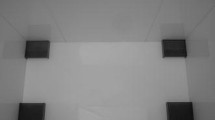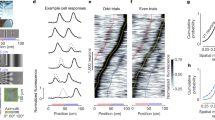Summary
-
1.
The aim of this study is to understand what a rodent (Meriones unguiculatus) learns about the geometrical relations between a goal and nearby visual landmarks and how it uses this information to reach a goal. Gerbils were trained to find sunflower seeds on the floor of a light-tight, black painted room illuminated by a single light bulb hung from the ceiling. The position of the seed on the floor was specified by an array of one or more landmarks. Once training was complete, we recorded where the gerbils searched when landmarks were present but the seed was absent. In such tests, gerbils were confronted either with the array of landmarks to which they were accustomed or with a transformation of this array.
-
2.
Animals searched in the appropriate spot when trained to find seeds placed in a constant direction and at a constant distance from a single cylindrical landmark (Fig. 1). Since gerbils look in one spot and not in a circle centred on the landmark, the direction between landmark and goal must be supplied by cues external to the landmark array. Distance, on the other hand, must be measured with respect to the landmark. Tests in which the size of the landmark was altered from that used in training suggest that distance is not learned solely in terms of the apparent size of the landmark as seen from the goal (Fig. 3).
-
3.
Gerbils can still reach a goal defined by an array of landmarks when the room light is extinguished during their approach (Figs. 4, 5). This ability implies that they have already planned a trajectory to the goal before the room is darkened. In order to compute such a trajectory, their internal representation of landmarks and goal needs to contain information about the distances and bearings between landmarks and goal.
-
4.
For planning trajectories, each landmark of an array can be used separately from the others (Fig. 7). Gerbils trained to a goal specified by an array of several landmarks were tested with one or more of the landmarks removed or with the array expanded. They then searched as though they had computed an independent trajectory for each landmark. For instance, gerbils trained with an array of two landmarks were tested with the distance between two landmarks doubled. The animals then searched for seeds in two positions, which were at the correct distance and in the right direction from each landmark.
-
5.
If an internal representation of an array of landmarks is to be used to plan a trajectory, landmarks seen on the ground must be matched to those held in memory. One way in which gerbils do this is by learning properties of individual landmarks, such as their shape, size or surface markings (Figs. 10, 11, 13). For example, gerbils were able to locate seeds defined by a single relevant landmark while ignoring an irrelevant landmark with different features which was placed randomly with respect to the goal.
-
6.
Several experiments (Figs. 4, 12, 13, 14) suggested that, although landmarks may be used independently for computing trajectories, the process of matching landmarks to the gerbil's representation requires a knowledge of the distances and directionsbetween landmarks.
-
7.
We conclude that a gerbil's representation of its environment is complete in that it stores explicitly or can compute from what it has stored the geometric arrangement of landmarks and goal. We discuss the possibility that its spatial memories consist of a set of vectors describing the distance and direction from the goal to each landmark (Fig. 18) and consider the advantages and disadvantages of such a goal-centred memory.
Similar content being viewed by others
References
Baker AG, Emerson VF (1983) Grating acuity of the mongolian gerbil. Behav Brain Res 8:195–208
Balda RP, Turek RJ (1984) The cache-recovery system as an example of memory capabilities in Clark's nutcracker. In: Roitblat HL, Bever TG, Terrace HS (eds) Animal cognition. Lawrence Erlbaum, Hillsdale London, pp 513–532
Cartwright BA, Collett TS (1983) Landmark learning in bees: experiments and models. J Comp Physiol 151:521–543
Morris RGM (1981) Spatial localisation does not require the presence of local cues. Learn Motivation 12:239–260
Naumov NP, Lobachev VS (1975) Ecology of desert rodents of the U.S.S.R. (Jerboas and gerbils). In: Prakash I, Ghosh PK (eds) Rodents in desert environments. Junk, The Hague, pp 465–598
O'Keefe J, Nadel L (1978) The hippocampus as a cognitive map. Clarendon Press, Oxford
Olton DS (1982) Spatially organised behaviours of animals: behavioural and neurological studies. In: Potegal M (ed) Spatial abilities: Development and physiological foundations. Academic, New York London Paris San Diego San Francisco Sao Paulo Sydney Tokyo Toronto, pp 335–360
Pick HL, Rieser JJ (1982) Children's cognitive mapping. In: Potegal M (ed) Spatial abilities: Development and physiological foundations. Academic, New York London Paris San Diego San Francisco Sao Paulo Sydney Toyko Toronto, pp 107–128
Roberts WA (1984) Some issues in animal spatial memory. In: Roitblat HL, Bever TG, Terrace HS (eds) Animal cognition. Lawrence Erlbaum, Hillsdale London, pp 425–444
Schöne H (1984) Spatial orientation — The spatial control of behaviour in animals and man. Princeton University, Princeton
Sherry DF (1985) Food storage by birds and mammals. Adv Study Behav 15:153–188
Suzuki S, Augerinos G, Black AH (1980) Stimulus control of spatial behaviour on the eight-arm maze in rats. Learn Motivation 11:1–18
Thomson JA (1980) How do we use visual information to control locomotion. Trends Neurosci 3:247–250
Tolman EC, Ritchie BF, Kalish D (1946a) Studies in spatial learning. 1. Orientation and the short-cut. J Exp Psychol 36:13–24
Tolman EC, Ritchie BF, Kalish D (1946b) Studies in spatial learning. 11. Place learning versus response learning. J Exp Psychol 36:221–229
Vander Wall SB (1982) An experimental analysis of cache recovery in Clark's nutcracker. Anim Behav 30:84–94
Wehner R (1981) Spatial vision in arthropods. In: Autrum H (ed) Vision in invertebrates (Handbook of sensory physiology, vol V11/6C). Springer, Berlin Heidelberg New York, pp 287–617
Wehner R, Räber F (1979) Visual spatial memory in desert ants,Cataglyphis bicolor (Hymenoptera: Formicidae). Experientia 35:1569–1571
Author information
Authors and Affiliations
Rights and permissions
About this article
Cite this article
Collett, T.S., Cartwright, B.A. & Smith, B.A. Landmark learning and visuo-spatial memories in gerbils. J. Comp. Physiol. 158, 835–851 (1986). https://doi.org/10.1007/BF01324825
Accepted:
Issue Date:
DOI: https://doi.org/10.1007/BF01324825




